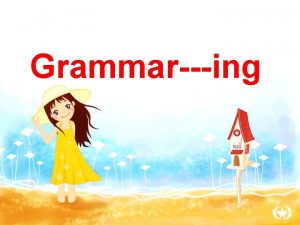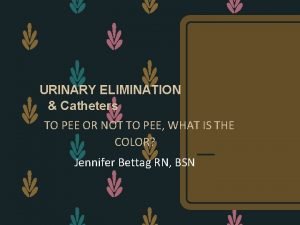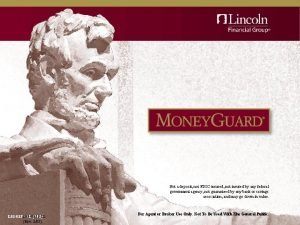To Pee or Not to Pee That is
















- Slides: 16

To Pee, or Not to Pee? That is the Question. Daily Life in Ancient Rome w/ Mr. C


Roman Hygiene �Hygiene in ancient Rome included the famous public Roman baths, toilets, exfoliating cleansers, public facilities, and -- communal toilet sponge (ancient Roman Charmin®). � high standards of cleanliness! � dutifully rinsed out after use!!! �Urns for collecting urine � for the fullers…

How did they wash? �Call for the bathroom attendant. �Dip hands in water. �Dry them on his head. �Don’t you want hair like Mr. C now? �Mine would be useless!!!

A ditty by Martial: �“In omnibus Vacerra quod conclavibus consumit horas et die toto sedet, cenaturit Vacerra, non cacaturit. ” �“Why does Vacerra spend his hours in all the privies, and day-long stoop? He wants a supper, not a poop. “ �What does this mean?

A ditty by Martial: �“Why does Vacerra spend his hours in all the privies, and day-long stoop? He wants a supper, not a poop. “ �Things like this tell us: � They were comfortable places � One might sit and read � Or otherwise "amuse oneself sociably" � Socialize and hope for [dinner] invitations

Urine Tax �Public urinals consisted of buckets, dolia curta. � The contents were regularly collected and sold to the fullers for cleaning wool, etc. �That's where the tax story comes in. � The fullers were the ones who were taxed. � The collectors had public contracts and could be fined if late. �FAVORITE STORY!!! �Emperor Vespasian (69 AD to 79 AD)

Titus Flavius Caesar Vespasianus Augustus �distrusted philosophers in general, viewing them as unmanly complainers who talked too much �Much money was spent on public works and the restoration and beautification of Rome: �a new forum, the Temple of Peace, the public baths and the great show piece, the �urinals are still named after him (for example, vespasiano in Italian, and vespasienne in French �Why?

Back to bathrooms and “pots” �“They were so poor they didn’t even have a pot to pee in. ” �Hygiene in the Roman World was limited to the rich and famous, except for those who could afford the public baths or thermaes. � Running water did not reach the poor's tenements from the aqueducts. �These lesser folks relieved themselves in pots or commodes which were emptied into vats located under staircases and these emptied into cesspools throughout the city.

The element, Plumbunium �The rich and famous, from the emperor on down, enjoyed running water in palaces and mansions from lead pipes connected to the aqueducts. �At Pompeii, for instance, all houses except the poorest had water pipes fitted with taps, and the waste water was piped away into sewer or trench.

Tools of the Trade � Strigil � Asmall, curved, metal tool used in ancient Greece and Rome to scrape dirt and sweat from the body before effective soaps became available. � First perfumed oil was applied to the skin, and then it would be scraped off, along with the dirt. � For wealthier people, this process was often done by slaves. � Strigils were often used in Roman baths and were made in different sizes for different areas of the body.

The Bath! �The Romans recycled public bath waste water by using it as part of the flow that flushed the latrines.

The Problem of Thieves �At the baths there were storage nooks for clothing, utensils, oil and strigil. �Theft was a problem in Roman bath houses, so slaves watched bathers' property. �It was better to have someone looking out, but hot as the baths were, it was easy to fall asleep. �Slaves could also be tempted by profit and sometimes sold their masters' garments.

So what to do? �Curse tablets punished those who stole. � Minerv(a)e de(ae) Suli donavi furem qui caracallam meam involavit si ser(v)us si liber si baro si mulier hoc donum non redemat nessi sangu(i)n[e] suo.

So what to do? �Curse tablets punished those who stole. � Curse tablets which were pieces of lead or pewter rolled or folded and thrown into the spring or nailed to the bathing establishment. Inscribing on his piece of lead the victim would call on the god to right the wrong, by bringing the criminal to justice and retrieving the lost article. � A victim of theft might seek the god's vengeance or double the likelihood of divine help by transferring ownership of his stolen garment (or other article of value) to the god who would then want to retrieve the garment in his own interest.

Next Time �Food �Bathrooms �City Life �Religion �Women �War �Home Life �Y mucho, mucho mas!
 Walmart thất bại ở nhật
Walmart thất bại ở nhật Gây tê cơ vuông thắt lưng
Gây tê cơ vuông thắt lưng Block xoang nhĩ
Block xoang nhĩ Tìm vết của mặt phẳng
Tìm vết của mặt phẳng Sau thất bại ở hồ điển triệt
Sau thất bại ở hồ điển triệt Thể thơ truyền thống
Thể thơ truyền thống Hãy nói thật ít để làm được nhiều
Hãy nói thật ít để làm được nhiều Thơ thất ngôn tứ tuyệt đường luật
Thơ thất ngôn tứ tuyệt đường luật Tôn thất thuyết là ai
Tôn thất thuyết là ai Ngoại tâm thu thất chùm đôi
Ngoại tâm thu thất chùm đôi Not genuine, not true, not valid
Not genuine, not true, not valid You can not not communicate
You can not not communicate Small just
Small just If you cannot measure it
If you cannot measure it Casual or informal
Casual or informal Love is not all about
Love is not all about We will not be moved when everything around is shaking
We will not be moved when everything around is shaking































